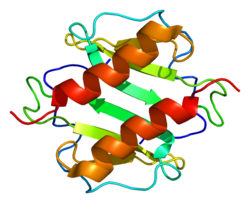CXCL1
| edit |
CXCL1, hemokin (C-X-C motiv) ligand 1, je mali citokin koji pripada CXC hemokin familiji. On se ranije zvao GRO1 onkogen, GROα, KC, neutrofil-aktivirajući protein 3 (NAP-3) i melanoma rast stimulišuća aktivnost, alfa (MSGA-α). Kod ljudi, ovaj protein je kodiran CXCL1 genom.[1][2]
Funkcija[uredi | uredi kod]
CXCL1 izlučuju ljudske ćelije melanoma. On ima mitogene osobine i učestvuje u patogenezi melanoma.[3][4] CXCL1 izražavaju makrofage, neutrofili i epitelske ćelije,[5][6] i dejstvuje kao neutrofilni hemoatraktant.[7][8] CXCL1 igra ulogu u razvoju kičmene moždine putem inhibicije migracije oligodendrocit prekursora, i učestvuje u procesima angiogeneze, inflamacije, zarastanja rana, i tumorigeneze.[9][10][11][12]
Ovaj hemokin dejstvuje putem signaliziranja kroz hemokin receptor CXCR2.[9] Gen za CXCL1 je lociran na ljudskom hromozomu 4 među genima za drugih CXC hemokina.[13] Jedna početna studija na miševima je proizvela evidenciju da CXCL1 umanjuje težinu multiple skleroze i da možda može da ima neuroprotektivnu ulogu.[14]
Reference[uredi | uredi kod]
- ↑ Haskill S, Peace A, Morris J, Sporn SA, Anisowicz A, Lee SW, Smith T, Martin G, Ralph P, Sager R (October 1990). „Identification of three related human GRO genes encoding cytokine functions”. Proc. Natl. Acad. Sci. U.S.A. 87 (19): 7732–6. DOI:10.1073/pnas.87.19.7732. PMC 54822. PMID 2217207.
- ↑ Mire-Sluis, Anthony R.; Thorpe, Robin, ur. (1998). Cytokines (Handbook of Immunopharmacology). Boston: Academic Press. ISBN 0-12-498340-5.
- ↑ Anisowicz A, Bardwell L, Sager R (October 1987). „Constitutive overexpression of a growth-regulated gene in transformed Chinese hamster and human cells”. Proc. Natl. Acad. Sci. U.S.A. 84 (20): 7188–92. DOI:10.1073/pnas.84.20.7188. PMC 299255. PMID 2890161.
- ↑ Richmond A, Thomas HG (February 1988). „Melanoma growth stimulatory activity: isolation from human melanoma tumors and characterization of tissue distribution”. J. Cell. Biochem. 36 (2): 185–98. DOI:10.1002/jcb.240360209. PMID 3356754.
- ↑ Iida N, Grotendorst GR (October 1990). „Cloning and sequencing of a new gro transcript from activated human monocytes: expression in leukocytes and wound tissue”. Mol. Cell. Biol. 10 (10): 5596–9. PMC 361282. PMID 2078213.
- ↑ Becker S, Quay J, Koren HS, Haskill JS (March 1994). „Constitutive and stimulated MCP-1, GRO alpha, beta, and gamma expression in human airway epithelium and bronchoalveolar macrophages”. Am. J. Physiol. 266 (3 Pt 1): L278–86. PMID 8166297.
- ↑ Moser B, Clark-Lewis I, Zwahlen R, Baggiolini M (May 1990). „Neutrophil-activating properties of the melanoma growth-stimulatory activity”. J. Exp. Med. 171 (5): 1797–802. DOI:10.1084/jem.171.5.1797. PMC 2187876. PMID 2185333.
- ↑ Schumacher C, Clark-Lewis I, Baggiolini M, Moser B (November 1992). „High- and low-affinity binding of GRO alpha and neutrophil-activating peptide 2 to interleukin 8 receptors on human neutrophils”. Proc. Natl. Acad. Sci. U.S.A. 89 (21): 10542–6. DOI:10.1073/pnas.89.21.10542. PMC 50375. PMID 1438244.
- ↑ 9,0 9,1 Tsai HH, Frost E, To V, Robinson S, Ffrench-Constant C, Geertman R, Ransohoff RM, Miller RH (August 2002). „The chemokine receptor CXCR2 controls positioning of oligodendrocyte precursors in developing spinal cord by arresting their migration”. Cell 110 (3): 373–83. DOI:10.1016/S0092-8674(02)00838-3. PMID 12176324.
- ↑ Devalaraja RM, Nanney LB, Du J, Qian Q, Yu Y, Devalaraja MN, Richmond A (August 2000). „Delayed wound healing in CXCR2 knockout mice”. J. Invest. Dermatol. 115 (2): 234–44. DOI:10.1046/j.1523-1747.2000.00034.x. PMC 2664868. PMID 10951241.
- ↑ Haghnegahdar H, Du J, Wang D, Strieter RM, Burdick MD, Nanney LB, Cardwell N, Luan J, Shattuck-Brandt R, Richmond A (January 2000). „The tumorigenic and angiogenic effects of MGSA/GRO proteins in melanoma”. J. Leukoc. Biol. 67 (1): 53–62. PMC 2669312. PMID 10647998.[mrtav link]
- ↑ Owen JD, Strieter R, Burdick M, Haghnegahdar H, Nanney L, Shattuck-Brandt R, Richmond A (September 1997). „Enhanced tumor-forming capacity for immortalized melanocytes expressing melanoma growth stimulatory activity/growth-regulated cytokine beta and gamma proteins”. Int. J. Cancer 73 (1): 94–103. DOI:10.1002/(SICI)1097-0215(19970926)73:1<94::AID-IJC15>3.0.CO;2-5. PMID 9334815.
- ↑ Richmond A, Balentien E, Thomas HG, Flaggs G, Barton DE, Spiess J, Bordoni R, Francke U, Derynck R (July 1988). „Molecular characterization and chromosomal mapping of melanoma growth stimulatory activity, a growth factor structurally related to beta-thromboglobulin”. EMBO J. 7 (7): 2025–33. PMC 454478. PMID 2970963.
- ↑ Omari KM, Lutz SE, Santambrogio L, Lira SA, Raine CS (January 2009). „Neuroprotection and remyelination after autoimmune demyelination in mice that inducibly overexpress CXCL1”. Am. J. Pathol. 174 (1): 164–76. DOI:10.2353/ajpath.2009.080350. PMC 2631329. PMID 19095949.
